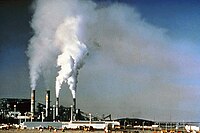
Photo from wikipedia
After only a few years operation, corrosion damage was observed in the flue gas cleaning system of a biomass power plant. The corrosion was on the lower part of the… Click to show full abstract
After only a few years operation, corrosion damage was observed in the flue gas cleaning system of a biomass power plant. The corrosion was on the lower part of the gas/gas heat exchanger fabricated from A242 weathering steel, where UNS S31600 bolts were used to attach sealing strips to the rotor. Thick iron oxides (up to 5 mm) had formed on the weathering steel, and these oxides also contained chlorine and sulfur. In this area of the heat exchanger, weathering steel has not had the optimal wet/dry cycles required to achieve a protective oxide. Due to the thick growing oxide on the rotor, the UNS S31600 bolts were under stress and this together with the presence of accumulated chlorine between the sealing strips and bolts resulted in stress corrosion cracking and rupture. In addition, Zn-K-Cl deposits were agglomerated in the duct after the DeNOx unit. Zn was also a constituent of corrosion products in various places in the ducts resulting in hygroscopic compounds. The presence of Zn in these cases was not from the fuel and is assumed to have originated from Zn containing primer (used to protect the plant during construction) reacting with flue gas constituents containing chlorine (KCl and HCl).
Journal Title: Journal of Failure Analysis and Prevention
Year Published: 2017
Link to full text (if available)
Share on Social Media: Sign Up to like & get
recommendations!